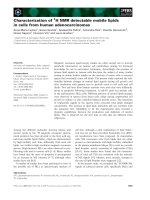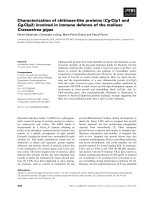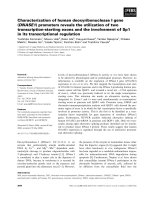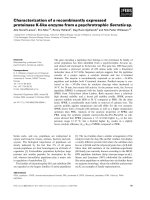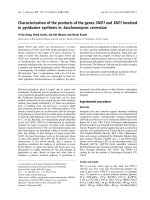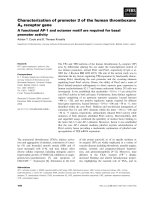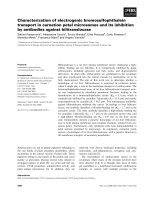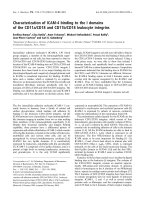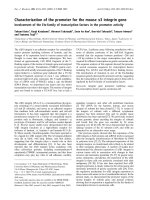Báo cáo khoa học: Characterization of isocitrate dehydrogenase from the green sulfur bacterium Chlorobium limicola A carbon dioxide-fixing enzyme in the reductive tricarboxylic acid cycle ppt
Bạn đang xem bản rút gọn của tài liệu. Xem và tải ngay bản đầy đủ của tài liệu tại đây (188.54 KB, 6 trang )
Characterization of isocitrate dehydrogenase from the green sulfur
bacterium
Chlorobium limicola
A carbon dioxide-fixing enzyme in the reductive tricarboxylic acid cycle
Tadayoshi Kanao, Mineko Kawamura, Toshiaki Fukui, Haruyuki Atomi and Tadayuki Imanaka
Department of Synthetic Chemistry and Biological Chemistry, Graduate School of Engineering, Kyoto University, Yoshida-Honmachi,
Sakyo-ku, Kyoto, Japan
Isocitrate dehydrogenase (IDH) catalyzes the reversible
conversion between isocitrate and 2-oxoglutarate accom-
panied by decarboxylation/carboxylation and oxidoreduc-
tion of NAD(P)
+
cofactor. While this enzyme has bee n well
studied as a catabolic enzyme in the tricarboxylic acid (TCA)
cycle, here w e have characterized NADP-dependent IDH
from Chlorobium limicola, a green sulfur bacterium that fixes
CO
2
through the reductive tricarboxylic acid (RTCA) cycle,
focusing on the CO
2
-fixation ability of the enz yme. The gene
encoding Cl-IDH consisted of 2226 bp, corresponding to a
polypeptide of 742 amino acid residues. The primary struc-
ture and the size of the recombinant protein indicated that
Cl-IDH was a monomeric enzyme of 8 0 kDa distinct from
the dimeric NADP-dependent IDHs predominantly found
in bacteria or eukaryotic mitochondria. Apparent Michaelis
constants for isocitrate (45 ± 13 l
M
) and NADP
+
(27 ± 10 l
M
) w ere much smaller than those for 2-oxoglut-
arate (1.1 ± 0.5 m
M
)andCO
2
(1.3 ± 0.3 m
M
). No signif-
icant diff erences in kinetic properties were observed between
Cl-IDH and the dimeric, NADP-dependent IDH from
Saccharomyces cerev isiae (Sc-IDH) at the optimum pH of
each enzyme. However, in contrast to the 20% activity of
Sc-IDH toward carboxylation as compared with that to-
ward decarboxylation at pH 7.0, the activities of Cl -IDH for
both directions were almost equivalent at this pH, suggesting
a more favorable property of Cl-IDH than Sc-IDH as a
CO
2
-fixation enzyme under physiological pH. Furthermore,
we found that among various intermediates, oxaloacetate
was a compe titive inhibitor (K
i
¼ 0.35 ± 0.04 m
M
)for2-
oxoglutarate in the carboxylation reaction by Cl-IDH, a
feature not found in Sc-IDH.
Keywords: isocitrate dehydrogenase; reductive tricarboxylic
acid cycle; CO
2
-fixing enzyme.
The r eductive tricarboxylic acid (RTCA) cycle is a carbon
dioxide (CO
2
) fixation pathway distinct from the well-
known reductive pentose phosphate cycle (Calvin–Benson
cycle) in plants, algae, and various bacteria. In this pathway,
four molecules of C O
2
are fixed t o produce one molecule of
oxaloacetate in one cycle. It has bee n suggested that the
RTCA cycle functions in anaerobic b acteria Chlorobium [1]
and Desulfobacter [2], thermophilic bacteria Hydrogeno-
bacter [3] and Aquifex [4], and also in the thermophilic
archaeon Thermoproteus [4]. The key enzymes of the RTCA
cycle are ATP-citrate lyase, and four CO
2
-fixing enzymes:
pyruvate synthase, phosphoenolpyruvate carboxylase,
2-oxoglutarate synthase, and isocitrate dehydrogenase
(IDH). As I DH is not specific for the RTCA cycle and is
widely distributed as a member of the tricarboxylic acid
(TCA) cycle, this enzyme has been extensively characterized
in terms of its contribution to the TCA cycle in various
species, including aero bic bacteria [ 5], f acultative anaerobic
bacteria [6], archaea [7], yeast [8], plants [9], and mammalian
tissues [10] [11].
IDH in the TCA cycle catalyzes the oxidative decarb-
oxylation of isocitrate to 2-oxoglutarate coupled with the
reduction of NAD(P)
+
. The IDH reaction is not only an
oxidation step in t he cycle for generation of reducing power
but also provides 2-oxoglutarate as an important inter-
mediate for glutamate biosynthesis. Indeed, deficiency of
this enzyme in Escherichia coli resulted in the auxotrophy
for glutamate [12]. IDH also comprises the branching point
between TCA cycle and glyoxylate cycle along with
isocitrate lyase. In E. coli and related bacteria grown on
C2 carbon sources, IDH is phosphorylated by the function
of IDH kinase/phosphatase, that leads to inactivation of the
enzyme and consequent switch of the carbon flux from TCA
cycle to glyoxylate cycle [13] [14].
There are two k inds of IDH with different cofactor
dependency, NAD- and NADP-dependent IDHs. Eukary-
otes possess both IDH isozymes, where NAD-dependent
enzymes a re a
4
b
4
heterooctamers localized in mitochond ria
to function in the T CA cycle, while NADP-dependent IDH
activities have been detected in th e cytosol, peroxisomes,
and mitochondria. It has been suggested that the eukaryotic
NADP-IDHs provide NADPH and 2-oxoglutarate for
biosynthesis of fatty a cids and a mino acids [9]. I n contrast,
Correspondence to T. Imanaka, Department of Synthetic Chemistry
and Biological Chemistry, Graduate School of Engineering,
Kyoto University, Yoshida-Honmachi, Sakyo-ku, Kyoto 606-8501,
Japan. Fax: + 8 1 75 7534703, Tel.: + 81 75 7535568,
E-mail:
Abbreviations: RTCA cycle, reductive tricarboxylic acid cycle; IDH,
isocitrate dehydrogenase; idh, the gene encoding isocitrate dehydro-
genase; Cl-IDH, isocitrate dehydrogenase from C hlorobium limicola;
Sc-IDH, NADP-dependent isocitrate dehydrogenase from Sacchar-
omyces cerevisiae; IPTG, isopropyl thio-b-
D
-galactoside.
Enzyme: isocitrate dehydrogenase (EC 1.1.1.42).
(Received 1 1 December 200 1, revised 1 8 February 2 002, accepted 20
February 2002)
Eur. J. Biochem. 269, 1926–1931 (2002) Ó FEBS 2002 doi:10.1046/j.1432-1033.2002.02849.x
bacteria possess only NADP-dependent IDH. These bacte-
rial and e ukaryotic NADP-dependent IDHs are usually
dimeric in structure, consisting of identical subunits with
molecular masses ranging from 40 to 57 kDa [9] [15]. In
addition to these enzymes, a limited number of m onomeric
IDHs with molecular masses of 80 kDa have been
identified from Azotobacter vinelandii [16], Vibrio
parahaemolyticus [17], Rhodomicrobium vannielii [18],
Desulfobacter vibrioformis [19], a nd Corynebacterium
glutamicum [20]. Psychrophilic Vibrio sp. strain ABE-1
possesses structurally distinct IDH isozymes of homodi-
meric (IDH-I) and monomeric (IDH-II) structures [21]. Th e
genes of monomeric IDHs have b een cloned and sequenced
from Vibrio sp. ABE-1 [22] and Cr. glutamicum [23], and
putative m onomeric IDH genes have been identified on t he
chromosomes of Chlorobium tepidum, Pseudomonas aeru-
ginosa, Mycobacterium leprae,andNeisseria meningitidis.
Comparison of the primary structures revealed little
overall similarity between these two types of NADP-
dependent IDHs [20] [23].
We have previously isolated the green sulfur bacterium
Chlorobium limicola strain M1, and have characterized one
of the key enzymes o f the RTC A cycle, ATP-citrate lyase
[24]. The results demonstrated the heteromeric structure o f
this enzyme and its role in regulating the d irection and flux
of the RTCA cycle. For further understanding of the R TCA
cycle, we are carrying out detailed investigations of each
member of the cycle. With respect to IDH, although the
activities have been detected in some autotrophic organisms
utilizing the RTCA cycle, no biochemical analysis of the
enzyme has been reported. Furthermor e, the catalytic
properties of IDH for the redu ctive carboxylation are much
less studied in comparison with those f or the o xidative
reaction.
In this report, we isolated the gene encoding IDH from
C. limicola (Cl-IDH) and characterized the r ecombinant
Cl-IDH as a CO
2
-fixing enzyme, and compared the catalytic
properties of Cl -IDH with those of dimeric NADP-depen-
dent IDH from Saccharomyces cerevisiae having different
physiological functions.
MATERIALS AND METHODS
Bacteria, plasmids, and media
The green sulfur bacterium C. limicola strain M1 was grown
phototrophically at 30 °C as described previously [24].
E. coli DH5a and pUC118 were used for DNA manipu-
lation and sequ encing. E. coli BL21(DE3) (Stratagene, La
Jolla, CA, USA) was used as a host f or an expression
plasmid derived from pET21a(+) (Novagen, Madison, WI,
USA). T hese strains were cultivated in Luria–Bertani
medium at 37 °C. When neces sary, 50 lgÆmL
)1
ampicillin
was supplied into the medium to maintain plasmids.
Isolation of the IDH gene (
idh
) from
C. limicola
Construction of a genomic DNA library of C. limicola M1
has been described previously [24]. A partial DNA fragment
of idh was amplified from C. limicola genomic DNA by
PCR using two primers corresponding to highly conserved
regions among monomeric IDHs. One primer (5¢-CAYC
TSAARGCNACSATGATG-3¢, N:A/T/G/C, Y:C/T,
S:G/C, R:A/G) was designed from HLKATMM from
position 251–257, and the other primer (5¢-AAYTGYTG
NACRTGYTTNGGNGC-3¢) w as a complementary
sequence of M AQKAEE from position 409–415 in mono-
meric IDH from Cr. glutamicum, respective ly. A phage
clone carrying the complete Cl-idh gene was screened from
the genomic library by plaque hybridization using the
amplified DNA fragment as a probe. A BamHI and SalI
restriction fragment containing the idh gene and its flanking
regions (6.0 kbp) was subcloned into pUC118.
DNA manipulation and sequencing
DNA manipulation was carried out according to the
methods described by Sambrook & Russell [25]. Prepara-
tion of plasmid DNA was performed with Plasmid Mini-
and Midi-Kits (Qiagen, Hilden, Germany) along with the
alkaline extraction method [25]. Nucleotide sequences of
both DNA strands were determined using a BigDye
Terminator Cycle Sequencing FS Ready Reaction Kit a nd
a Model 310 capillary DNA sequencer (Applied Biosystems,
Foster City, CA, USA). The multiple alignment o f protein
sequences and the identity and similarity between sequences
were obtained with the program
ALIGN
contained within the
CLUSTALW
program provided by DNA Data Bank of Japan
(DDBJ). The sequence data was analyzed using
GENETYX
software package (Software Development, Tokyo, Japan).
The nucleotide sequence data of Cl-idh will appear in the
EMBL, GenBank, and DDBJ nucleotide sequence data-
bases under accession no. AB076021.
Expression of
C. limicola idh
gene and purification
of the recombinant enzyme
In order to c onstruct an expression vector for Cl -idh,two
oligonucleotides (sense, 5¢-A AAAA
CATATGGCAAGCA
AATCGACCATCATCTACAC-3¢, and antisense, 5¢-AAA
AA
GGATCCCGGCTGAAAACCGGGCTGCATTA-3¢)
were designed for amplification of idh flanked with NdeI
and BamHI sites (underlined). After confirming the nucle-
otide sequence, an NdeI–BamHI fragment of the amplified
idh gene was ligated with pET21a(+) at the corresponding
sites. The expression vector, named pET-IDH, was intro-
duced into E. coli BL21(DE3), and the recombinant cells
were cultured in Luria–Bertani medium containing
50 lgÆmL
)1
ampicillin at 37 °C. Expression of idh in the
recombinant cells under the control o f T7 promoter was
induced for 3 h a t 3 7 °C a fter the addition o f 0 .1 m
M
isopropyl thio-b-
D
-galactoside (IPTG) when D
660
¼ 0.4.
The cells harvested from a 3-L culture were washed twice
with 0.1
M
potassium phosphate buffer ( pH 7.2), a nd
resuspended in t he same buffer. The cells were disrupted
by sonication on ice, and then centrifuged for 15 min at
15 000 g to remove cell debris. The soluble fraction was
applied onto a Resource Q anion exchange column (Amer-
sham Pharmacia Biotech, Uppsala, Sweden) b y using an
A
¨
KTA explorer 10S apparatus (Amersham Pharmacia
Biotech). After equilibrating and washing with 20 m
M
potassium phosphate buffer (pH 7.2), Cl-IDH was eluted
by a linear gradient of KCl (0–0.5
M
) in the same buffer with
a flow rate of 2 mLÆmi n
)1
. The active fraction was
concentrated and further applied onto a Superdex200
HR10/30 g el-filtration column (Amersham Pharmacia
Ó FEBS 2002 Isocitrate dehydrogenase from Chlorobium limicola (Eur. J. Biochem. 269) 1927
Biotech) at a flow rate of 0.35 mL Æmin
)1
. All purification
steps were carried out at 4 °C . The active fractions were
examined for ap parent homogeneity by SDS/PAGE. Pro-
tein concentration was determined by a Bio-Rad Protein
Assay system (Bio-Rad, Hercules, CA, USA) with bovine
serum albumin as a standard.
Enzyme assays
Activities of Cl-IDH and NADP-dependent dimeric IDH
from S. cerevisiae (Oriental Yeast, Osaka, Japan) were
determined s pectrophotometrically at 25 °C . In the d ecarb -
oxylic reaction, the assay mixture contained 0 .4 m
M
triso-
dium
DL
-isocitrate, 0.2 m
M
NADP
+
,40m
M
MgCl
2
,and
enzyme solution in 1 m L of 100 m
M
2-(cyclohexylamino)-
ethanesulfonic acid (Ches) buffer (pH 9.0). T he increase of
NADPH was detected by absorbance at 340 nm, and one
unit of activity was defined as 1 lmol of NADPH formed
per min. In the carboxylation reaction, the mixture was
composed of 8 m
M
sodium 2-oxoglutarate, 0.16 m
M
NADPH, 40 m
M
MgCl
2
,35m
M
NaHCO
3
, and enzyme
solution in 1 mL of 100 m
M
N-2-hydroxyethylpiperazine-
N¢-2-ethanesulfonic a cid ( Hepes) buffer (pH 7.0). I n order
to accurately quantify NaHCO
3
,0.5
M
stock solution of
NaHCO
3
in the buffer was preincubated for 1 h before use
in an adequately sealed bottle to avoid equilibration with
atmospheric CO
2
. After addition of the NaHCO
3
stock
solution to the reaction mixture in a s ealed cuvette, further
incubation at 25 °C for 5 min was carried out for equili-
bration before a ddition o f t he enzyme solution. The
consumption of NADPH was monitored at 340 nm, and
one unit of activity was defined as 1 lmol of NADPH
oxidized per min. For determination of optimum pH in each
reaction, 2-(N-morpholino)ethanesulfonic acid (Mes) buf-
fers with pH values from 5.0 to 7.0, Hepes buffers with pH
values from 7.0 to 8.5, N,N-bis(2-hydroxyethyl)glycine
(Bicine) buffers with pH values from 8.0 to 9.0, and Ches
buffers with pH values f rom 8 .7 to 10.0 were used for the
assay.
RESULTS
Isolation of the
idh
gene from
C. limicola
In the cell-free extract of C. limic ola strain M1, we could
detect NADP-dependent IDH a ctivity toward isocitrate
with a specific activity of 0.85 UÆmg
)1
, a s previously shown
in the c losely re lated g reen sulfur bacterium, C. thiosulfato-
philum [1]. Steen et al . have recently reported the presence
of IDH in a related thermophile C. tepidum by activity
staining after SDS/PAGE, in which t he active band
corresponded in size (80 kDa) to monomeric IDH from
Desulfobacter vibrioformis [19]. We therefore supposed that
IDH from C. limicola is likely to be a monomeric enzyme.
Two primers were designed from conserved regions among
known monomeric IDHs (See Materials and methods), and
PCR with the primers and genomic DNA from strain M1
gave successful amplification of a 1-kbp DNA fragment.
The c omplete idh gene was isolated from C. limicola
genomic library by using the amplified fragment as a p robe.
DNA s equencing analysis r evealed that t he Cl-idh gene
consisted of 2226-bp and encoded a protein w ith a
molecular m ass of 80 465 Da. Putative r ho-independent
terminator was located 27-bp downstream of the stop
codon. However, typical consensus sequences for ribosome
binding and f or a p romoter w ere not identified in the
5¢-flanking region of Cl-idh. No open reading frames were
found in the immediate vicinity of the gene.
The deduced amino-acid sequence of Cl-IDH was 66.0%
and 57.4% identical to monomeric IDHs from Vibrio sp.
strain ABE-1 (IDH-II) and from Cr. glutamicum, respect-
ively. K253 in IDH f rom Cr. glutamicum had been expected
to be a proton donor during the decarboxylation o f
isocitrate, and indeed, the site-specific mutagenesis of
K253 to Met led to an inactive protein [23]. In addition,
the alkylation of the adjacent M258 inactivated the IDH
from A. vinelandii [26]. These Lys and Met residues were
conserved in Cl-IDH at the position of 256 and 259,
respectively. In dimeric IDH from E. coli (Ec-IDH), K344
and Y 345 were interacted with 2¢-phosphate of NADP
molecule [23] and the positively charged residues were
highly con served in monomeric IDHs and supposed to
contribute t o t heir high specificity toward NADPH. K589
and H590 i n Cl-IDH were proposed to be equivalent to t he
residues in Ec -IDH.
Expression and purification of IDH from recombinant
E. coli
A high level of NADP-dependent IDH activity c ould be
detected in the cell-free extract after ind uction with IPTG.
The activity of the recombinant cell-extract (19.5 UÆmg
)1
)
was 100-fold higher than that in the host cells (0.20 UÆmg
)1
).
The homogeneity of the recombinant p rotein was a nalyzed
with SDS/PAGE (data not shown) and native-PAGE
(Fig. 1 ) analyses, and the specific activity of the purified
IDH reached 36.0 UÆmg
)1
(Table 1). The molecular mass of
the native enzyme was determined to be 81 kDa by gel-
filtration column chromatography and 80 k Da by native-
PAGE. Th e results indicated that the recombinant IDH was
a monomeric enzyme with a molecular mass of 80 kDa. No
IDH activity was detected when NADH was used as a
cofactor.
Kinetic properties, pH profiles of
Cl
-IDH
and comparison with NADP-dependent IDH
from
S. cerevisiae
The catalytic properties of IDH from C. limicola were
investigated for both the oxidative decarboxylation and
reductive carboxylation r eactions. The activity for oxidative
decarboxylation of isocitrate was assayed by standard
procedures. The optimum pH was 9.0 (Fig. 2A),
and a pparent K
m
values for isocitrate a nd NADP
+
at the
optimum pH were determined to be 45 ± 13 l
M
and
27 ± 10 l
M
, respectively (Table 2). The reductive carboxy-
lation activity towards 2-oxoglutarate was determined also
by spectrophotometry. As both the monomeric and d imeric
IDHs have been reported to accept CO
2
molecule as a
substrate [27] [28], the reaction mixture was sufficiently
equilibrated after addition of NaHCO
3
solution prior to
assay in a capped c uvette. The optimum pH for carboxy-
lation was 7 .0 (Fig. 2A), where the C O
2
concentration after
the equilibration was 17.9% (6.27 m
M
) of initial bicarbonate
concentration (35 m
M
). Under t his reaction condition,
Cl-IDH showed normal M ichaelis–Menten k inetics also
1928 T. Kanao et al. (Eur. J. Biochem. 269) Ó FEBS 2002
for the carboxylation reaction. Apparent K
m
values for
2-oxoglutarate and CO
2
were 1.1 ± 0.5 m
M
and
1.3 ± 0.3 m
M
, respectively, which were much greater than
the values f or isocitra te and N ADP
+
. The kinetic param-
eters of monomeric IDHs from C. limicola and A. vinelan-
dii, p reviously determined by Wicken et al. [28], are also
shown in Table 2. In addition, we further examined the
catalytic properties of NADP-dependent IDH f rom
S. cerevisiae (Sc-IDH) in order to compare the properties
of monomeric IDHs with those of a dimeric enzyme. The
optimum pH for the decarboxylation and carboxylation
activities of Sc-IDH were 8.5 and 6.0 (Fig. 2B), and
apparent K
m
values for isocitrate, NADP
+
, 2-oxoglutarate,
and CO
2
were 20 ± 5 l
M
,33±6l
M
,0.85±0.30m
M
,
and 8.2 ± 1.0 m
M
, respectively (Table 2). The results
suggested that differe nces in the properties were not so
significant among the three enzymes for both the directions.
However, an interesting difference between Cl-IDH
and Sc-IDH was observed in the activities at pH 7.0. The
decarboxylic and c arboxylic activities of Cl-IDH ( 46.0 and
41.0 U Æmg
)1
, r espectively) were almost equivalent under
physiological conditions (Fig. 2A), in contrast to the m uch
higher activity for d ecarboxylation o f Sc-IDH
(41.0 UÆmg
)1
) than t hat f or car boxylation (8.7 UÆmg
)1
)at
pH 7 .0 (Fig. 2B).
Fig. 1. Native-PAGE of recombinant Cl-IDH. The a ctive fraction after
Superdex200 gel-filtration column chromatography was applied to
lane 1. Lane M, molecular markers, thyroglobulin (669 000 Da),
ferritin (440 000 Da), catalase (232 000 Da), lactate dehydrogenase
(140 00 0 Da), a lbum in (66 0 00 Da).
Fig. 2. Effect of pH on the de carboxylation (open symbols) and carb-
oxylation (closed symbols) activities of Cl-IDH (A) and Sc-IDH (B).
Assays were performed i n e ach buffer as follows; Mes (r,e), Hepes
(j,h), Bicine ( m,n), CHES (d,s).
Table 2. Comparison o f kinetic pro perties of ID Hs. Cl, Chlorobiu m limico la ; Sc, Saccharomyces cerevisiae; Av, Azotobacter vinelandii.
Reaction Properties Cl-IDH Sc-IDH Av-IDH
(28)
Decarboxylation K
m
(l
M
)
Isocitrate 45 ± 13 20 ± 5 6.8
NADP 27 ± 10 33 ± 6 8.3
V
max
(UÆmg
)1
) 150 ± 6 54 ± 5 130
Carboxylation K
m
(m
M
)
2-Oxoglutarate 1.1 ± 0.5 0.85 ± 0.30 0.0139
CO
2
1.3 ± 0.3 8.2 ± 1.0 0.39
V
max
(UÆmg
)1
) 38±9 16±2 –
Table 1. Purification o f Cl-IDH from recombinant E. co li. IDH activity was measured with carboxylation reaction.
Step
Total protein
(mg)
Total activity
(U)
Specific activity
(UÆmg
)1
)
Yield
(%)
Purification
(fold)
Cell-free extract 254 4950 19.5 100 1
ResourceQ 100 2640 26.4 53.3 1.35
Superdex200 58.4 2100 36.0 42.5 1.84
Ó FEBS 2002 Isocitrate dehydrogenase from Chlorobium limicola (Eur. J. Biochem. 269) 1929
Inhibition of carboxylation activity of
Cl
-IDH
by oxaloacetate
We further examined the effects of intermediate compounds
in the RTCA cycle on Cl -IDH ac tivity. C itrate, p yruvate,
succinate, fumarate, m alate, glyoxylate, ATP, and ADP
gave no significant effect on the carboxylation reaction
(data not shown). H owever, considerable inhibition was
observed when oxaloacetate was added into t he mixture.
The carboxylation activity decreased to more t han half in
the presence of 1 m
M
oxaloacetate (Fig. 3 A). In contrast, up
to 5 m
M
oxaloacetate had no influence on the carboxylation
activity of Sc-IDH. The Dixon plot for o xaloacetate with
different concentrations of 2-oxoglutarate displayed typical
competitive inhibition, and a K
i
value of oxaloacetate for
Cl-IDH was determined to be 0.35 ± 0.04 m
M
(Fig. 3 B).
Similar to previous reports with IDHs from various sources,
a concerted inhibition with oxaloacetate a nd glyoxylate was
also observed against Cl-IDH. By a ddition of 0.25 m
M
glyoxylate t ogether with the same concentration o f
oxaloacetate (0.25 m
M
), the decarboxylation activity was
decreased to 44%, w hile relative activity was 77% wit hout
glyoxylate (data not s hown).
DISCUSSION
In this paper, we investigated IDH from the green sulfur
bacterium, C. limicola,asaCO
2
-fixing enzyme in RTCA
cycle. The enzyme IDH from C. limicola was revealed t o be
a monomeric enzyme with a molecular mass of 80.5 kDa.
The deduced amino-acid sequence of Cl-idh gene showed
high similarities to other monomeric IDHs from Vibrio sp.
strain ABE-1 and Cr. g lutamicum. However, no signi ficant
similarity was observed between monomeric and dimeric
IDHs in their primary structures, suggesting that t hese two
distinct IDHs evolved independently from different ances-
tors.
We compared the catalytic properties of Cl -IDH with
those o f Sc-IDH. Both IDHs exhibited higher affinities to
substrates for decarboxylation (NADP
+
and isocitrate)
than those for carboxylation (2-oxoglutarate and CO
2
), and
the specific activities toward decarboxylation were higher
than those toward the reverse direction at the respective
optimum pH. The kinetic parameters of monomeric I DH
from A. Vinelandii also showed the same tendency
(Table 2). These results indicated that there was not such
a significant difference between Cl-IDH and the counter-
parts from aerobic microorganisms. These IDHs could
catalyze oxidat ive decarboxylation m ore efficiently com-
pared to reductive carboxylation.
However, it is interesting to note that the ratios of
carboxylation and decarboxylation activities at pH 7.0,
presumably close to the physiological pH, showed a clear
difference between Cl-IDH and Sc-IDH. The activity of
Sc-IDH toward decarboxylation was fivefold higher than
that toward carboxylation at pH 7 .0 (Fig. 2B), suggesting
that the decarboxylic reaction was predominant over the
carboxylic reaction in vivo. This result is consistent with the
fact that the NADP-dependent IDH contributes to provide
NADPH f or reduction of unsaturated f atty acid in
S. cerevisiae [29]. In contrast, the carboxylation activity o f
Cl-IDH at pH 7.0 was as high as the decarboxylation
activity (Fig. 2 A). Cl-IDH possessed a more favorable
property to fix CO
2
than Sc-IDH under physiological
conditions.
Among the intermediates of RTCA cycle, oxaloacetate
affected activities of Cl-IDH. More than half of the activity
was i nhibited by 1 m
M
oxaloacetate in both d irections, and
the inhibition for carboxylation was shown to be compet-
itive. Inhibition by oxaloacetate has been examined for
dimeric IDHs and a few monomeric IDHs fr om
Cr. g lutamicum and A. vinelandii. The enzymes displayed
low (5–27%), or only trivial (0–5%) levels of inhibition by
1m
M
oxaloacetate. Although these results were obtained
against d ecarboxylic activi ty, w e confirmed that even 5 m
M
oxaloacetate gave no inhibition to the carboxylation activity
of Sc-IDH (Fig. 3A). IDHs seemed to be gene rally inse n-
sitive against oxaloacetate. One exception is the I DH from
purple nonsulfur bacterium R. vannielii, which showed
44% inhibition with 0.2 m
M
oxaloacetate [18]. This indi-
cates that the strong inhibition by oxaloacetate was not a
specific property for an IDH which functions in the RTCA
cycle.
The question remains whether Cl-IDH is actually inhib-
ited by oxaloacetate in vivo. Malate dehydrogenase is known
to predominantly catalyze the reduction of oxaloacetate to
malate, and thereby lowering the p ossibilities of oxaloacetate
accumulation. Indeed, when we have analyzed the malate
dehydrogenase a ctivity in the cell-free extracts of C. limico-
la,0.95UÆmg
)1
activity in the direction o f m alate synthesis
could be detected (data not shown). However, a lthough a
closely related strain Chlorobium thiosulfatophilum also
harbors the same levels of malate dehydrogenase
(0.62 UÆmg
)1
[1]), previous radiolabeling experiments dem-
onstrated a large accumulation of oxaloacetate in the cells,
relative to other intermediates [30]. In the cells of
C. thiosulfatophilum grown i n a medium containing
3
H
2
O,
the radioactivity of oxaloacetate was 3.6-fold greater t han
that of malate and 21-fold greater t han that of the sum of
citrate and isocitrate. I n addition,
14
CO
2
-labeling indicated
that oxaloacetate was one of the first stable products of
photosynthesis by C. thiosulfatophilum [30]. These results
suggested that oxaloacetate was pooled in Chlorobium cells
despite the presence of high malate dehydrogenase activity,
and t he concen tration w ould s ensitively refle ct the level of
carbon assimilation by the cycle. As we previously repo rted,
ATP-citrate lyase from C. limic ola catalyzes only t he
Fig. 3. Inhibition of Cl -IDH with oxaloacetate. (A) E ffect of oxaloac-
etate concentration on the carboxylation activities of Cl-IDH (j)and
Sc-IDH ( h). (B ) Dixon-plots for oxaloacetate w ith 3 m
M
(d), 5 m
M
(m), and 1 0 m
M
(s) 2-oxoglutarate.
1930 T. Kanao et al. (Eur. J. Biochem. 269) Ó FEBS 2002
ATP-dependent cleavage of citrate and the activity w as
inhibited at higher ADP/ATP ratios [24]. RTCA cycle is
considered to be driven excessively by ATP-citrate lyase
under sufficient energy conditions that might lead t o
overaccumulation of oxaloacetate within the cells. The
inhibition of Cl-IDH carboxylic reaction by oxaloacetate or
by that concerted with g lyoxylate could suppress the cycle in
order to change the carbon flux to other p athways, s uch a s
glutamate b iosynthesis, under the condition of excess
turnover o f the RTCA cycle. Further studies of the enzyme
will clarify the structure, functions, and regulation in th e
RTCA cycle.
REFERENCES
1. Evans, M.C.W., Buchanan, B.B. & Arnon, D.I. (1966) A new
ferredoxin-depen dent carbon reduction cycle in a pho tosynthetic
bacterium. Proc. Natl Acad. Sci. USA 55 , 928–934.
2. Schauder, R., Widdel, F. & Fuchs, G. (1987) Carbon assimilation
pathways in sulfate-reducing bacteria II. Enzymes of a reductive
citric acid cycle i n the autotrophic Desulfobacter hydrogenophilus.
Arch. Microbiol. 148, 218– 225.
3. Shiba, H., Kawasumi, T., Igarashi, Y., Kodama, T. & Minoda, Y.
(1985) The C O
2
assimilation via the reductive tricarboxylic acid
cycle in an obligately autotrophic, aerobic h ydrogen-oxidizing
bacterium Hydrogenobacter thermophilus. Arch. Microbiol. 141,
198–203.
4. Beh, M., Strauss, G., Huber, R., Stetter, K O. & Fuchs, G. (1993)
Enzymes of the reductive citric acid cycle in the autotrophic
eubacterium Aquifex pyrophilus and in the archaebacterium
Thermoproteus neutrophilus. Arch. Microbiol. 160 , 306–311.
5. Ramaley, R.F. & Hudock, M.O. (1973) Purification and proper-
ties of isocitrate dehydrogenase (NADP) f rom Thermus aquaticus
YT-I, Bacillus subtilis-I68 and Chlamydomonas reinhardti-Y-2.
Biochim. Bio phys. Acta 315, 22–36.
6. Reeves, H.C., Daumy, G.O., Lin, C.C. & Houston, M. (1972)
NADP
+
-specific iso citrate dehydrogenase o f Escherichia coli.I.
Purification and characterization. Biochim. Biophys. Acta 258,
27–39.
7. Steen, I.H., Lien, T. & Birkeland, N K. (1997 ) B iochemical and
phylogenetic characte riz ation of isocitrate dehydrogenase from a
hyperthermophilic archaeon, Archaeoglobus fulgidus. Arch.
Microbiol. 16 8, 412–420.
8. Haselbeck, R.J. & McAlister-Henn, L. (1993) Function and
expression of yeast mitochondrial NAD- and NADP-specific
isocitrate dehydrogenases. J. Biol. Chem. 26 8, 12116–12122.
9. Chen, R D. & Gadal, P. (1990) Structure, functions and regu la-
tion of NAD and NADP dependent isocitrate dehydrogenases in
higher plants and in other organisms. Plant Physiol. Biochem. 28,
411–427.
10. Plaut, G.W.E. & Aogaichi, T. (1968) Purification and properties of
diphosphopyridine nucleotide-linked isocitrate dehydrogenase of
mammalian liver. J. Biol. C hem. 243, 5572–5583.
11. Ehrlich, R.S. & Colman, R.F. (1983) Separation, recombination,
and characterization of dissimilar subunits of th e DPN-dependent
isocitrate dehydrogenase from pig heart. J. Biol. Chem. 258, 7079–
7086.
12. Thorsness, P.E. & Koshland, D.E. Jr (1987) Inactivation of
isocitrate d ehydrogenase b y p ho sphorylation is mediated by
thenegativechargeofthephosphate.J. Biol. Chem. 262,
10422–10425.
13. Nimmo, H.G. (1987) Regulation of bacterial metabolism by
protein phosphorylation. Essays Bi ochem. 23, 1–27.
14. Cozzone, A.J. (1998) Regulation of acetate metabolism by protein
phosphorylation in enteric bacteria. Annu. Rev. Microbiol. 52,
127–164.
15. Muro-Pastor, M.I. & Florencio, F.J. (1994) NADP
+
-isocitrate
dehydrogenase from the cyanobacterium Anabaena sp. strain PCC
7120: purification and characterization of the enzyme and cloning,
sequencing, and disruption of the icd gene. J. Bacteriol. 176,
2718–2726.
16. Chung, A.E. & Franzen, J.S. (1969) Oxidized triphosphopyridine
nucleotide speci fic isocitrate d ehydrogenase from Azotobacter
vinelandii. Isolation and characterization. Biochemistry 8,
3175–3184.
17. Fukunaga, N., Imagawa, S. , Sahara, T., Ishii, A. & Suzuki, M.
(1992) Purification and ch aracterization of mo nomeric isocitrate
dehydrogenase with NADP
+
-specificity from Vibrio parahaemo-
lyticus Y-4. J. B io che m. 112, 849–855.
18. Leyland, M .L. & Kelly, D.J. (1991) Purification and character-
ization of a monomeric isocitrate dehydrogenase with dual
coenzyme specifi city from the pho tosynth etic b acterium Rhodo-
microbium v annielii. Eur. J. Biochem. 202, 8 5–93.
19. Steen, I.H., Madsen, M.S., Birkeland, N K. & Lien, T . (1998)
Purification and characterization of a monomeric isocitrate
dehydrogenase from the sulfate-reducing bacterium Desulfobacter
vibrioformis and demonstration of th e presence of a monomeric
enzyme in other bacteria. FEMS Microbiol. Lett. 160, 75–79.
20. Eikmanns, B.J ., Rittmann, D . & S ahm, H. (19 95) Cloning,
sequence analysis, expression, and inac tivation of t he
Corynebacterium g lutamicum i cd ge ne enco ding isocitrate d ehy-
drogenase and biochemical characterization of the enzyme.
J. Bacteriol. 177, 774– 782.
21. Ishii, A., Ochiai, T., Imagawa, S., Fukunaga, N., Sasaki, S.,
Minowa, O., Mizuno, Y. & Shiokawa, H. (1987) Isozymes of
isocitrate dehydrogenase from an obligately psychrophilic
bacterium, Vibrio sp. strain ABE-1: purification, and
modulation of activities by growth conditions. J. Biochem. 102,
1489–1498.
22. Ishii, A., Suzuki, M., Sahara, T., Takada, Y., Sasaki, S. &
Fukunaga, N. (1993) Genes encoding two isocitrate dehy-
drogenase isozymes of a psychrophilic bacterium, Vibrio sp. strain
ABE-1. J. Bacteriol. 175, 6873–6880.
23. Chen, R. & Yang, H . (2000) A highly specific monomeric iso-
citrate dehydrogenase from Corynebacterium glutamicum. Arch.
Biochem. Biophys. 383, 2 38–245.
24. Kanao, T., Fukui, T., Atomi, H. & Imanaka, T. (2001) ATP-
citrate lyase from the green sulfur bacterium Chlorobium limicola is
a h eterome ric enzyme composed of two distinct gene products.
Eur. J. Biochem. 268, 1 670–1678.
25. Sambrook, J. & Russell, D .W. (2001) Mol ecular Cloning: a
Laboratory Manual, 3rd edn. Cold Spring Harbor Laboratory
Press, Cold Spring Harbor, New York.
26. Edwards, D.J., Heinrikson, R.L. & Chung, A.E. (1974) Triphos-
phopyridine nucleotide specific isocitrate dehydrogenase from
Azotobacter vinelandii. Alkylation of a specific methionine residue
and amino acid sequence of th e peptide containing this residue.
Biochemistry 13 , 677–683.
27. Dalziel, K. & Londesborough, J.C. (1968) The mechanisms of
reductive carboxylation reac tions. Carb on dioxide or bicarbonate
as substr ate of n icotinamide-adenine dinucleotide phosphate-
linked isocitrate dehydrogenase and ÔmalicÕ enzyme. Biochem. J.
110, 223–230.
28. Wicken, J.S., Chung, A.E. & Franzen, J.S. (1972) Isocitrate
dehydrogenase from Azotobacter vinelandii. Order of substrate
addition and p roduct release. Bioc hemistry 11, 4766–4778.
29. van Roermund, C.W.T., Hettema, E.H., Kal, A.J., van den Berg,
M., Tabak, H.F. & Wanders, R.J.A. (1998) Peroxisomal b-oxi-
dation of polyunsaturated fatty acids in Saccharomyces cerevisiae:
isocitrate de hydrogenase provides N ADPH for reduction of
double bonds at e ven positions. EMBO J. 17 , 677–687.
30. Sireva
˚
g, R. (1974) Further studi es on carbon dioxide fixation in
Chlorobium. Arch. M icrobiol. 98, 3–18.
Ó FEBS 2002 Isocitrate dehydrogenase from Chlorobium limicola (Eur. J. Biochem. 269) 1931
